Mount Kilimanjaro is Africa’s most famous mountain. Appearing on almost every product from beer to chocolate, currency and stamps in Tanzania, Mt Kilimanjaro is heavily present in people’s consciousness. This full guide to climbing Mt Kilimanjaro is descriptive and contains in depth information about everything you’d need to know before planning to climb Kilimanjaro.
Equipment is basically divided into two parts. One that you will need to buy (even better if you already own them), and the second that will be provided by your agency, whether already included in the price or rented separately. Renting is a great way of ensuring that you do not end up paying for equipment that you won’t use much as well as save space and weight on your flight. Details about the packing list are further below.
Essentials:
Sleeping Bag
Water Bottles
Water Filter / Purifier tablets
Sunglasses
Head Torch
Sunscreen
Rucksack
Daypack
Clothes
Trekking Boots
Jackets
Down Jacket
Waterproof Jacket
Socks
Thermal Underwear
Trousers
Trekking trousers
Waterproof Trousers
T-Shirts
Hats
Sunhat
Warm thermal hat
Gloves
Rain coat / Poncho
Shorts
Bandana
Medical Kit
Diamox
Antimalarials - Malarone
Aspirin
Paracetamol
Chapstick / Vaseline
Sterilized Needles - in case you need a shot in Tanzania
Plasters / Bandaids
Antiseptic Cream / ointment
Ice Packs - the squeeze and cool variant
Lens Fluid - if you wear contact lenses
Lozenges
Water flavour powder / electrolytes
Other Equipment
Trekking Poles - can be rented
Earplugs
Gaiters - can be rented
Sandals
Camera Equipment
Batteries
Shoelaces / String
Clothes Pegs
Penknife
Tape
Water Purifier /Tablets
Food
The major difference which is felt between luxury and budget operators is the food that you are served on the Kilimanjaro trek. Do also note that the money you pay has to cover not only the your food, but the food for your porters, and guides as well. With a decent group size of about 10 people, your crew will be between thirty and fifty people and your budget will have to cater for their requirements as well.
Climbing Mt Kilimanjaro - Breakdown of Cost
Assuming a 7 day trek
Park Fees
Conservation Fee - $70 * 7 days - $490
Camping Fee - $50 * 6 nights- $300
Rescue Fee - $20 per person- $20
Entry Fee for crew - approx - $20
People Costs
Guide - $20 * 7 days - $140
Assistant Guide - $15 * 7 days - $105
Porters x 3 - $10*3*7 days- $210
Food Costs
You plus crew - 7 days - $250
Transportation Costs
Pickup to from hotel + airport $150
Total- $1,685
Variations may include more porters, guide fees and different transport costs, plus the costs of the climbing company. There is usually one main guide for the group and one assistant guide per three or four people. Having more people in your climbing group will reduce the shared costs of the guides, transport and food.
Of course, this is just the part of the fee that is covered by the trekking agency when they quote you your price. The costs for equipment, tips for your crew, flights, visa and passport and other myriad things are not included in this estimate.
Flights to Kilimanjaro
When you book a flight to Kilimanjaro, there are four major airports that you can fly into in Tanzania, and one into Kenya (Nairobi). This not only includes flights, but also how to travel to Kilimanjaro overland. The airports catering to international flights in Tanzania are:
Abeid Amani Karume International Airport in Zanzibar, previously called Zanzibar International Airport
Julius Nyerere International Airport in Dar es Salaam, previously called Dar Es Salaam International Airport
Mwanza Airport, located on the shores of Lake Victoria
There is also the small Arusha airport which caters to private chartered flights, although most flights here come through from JRO.
As of 2017, you will find the following Airlines operating flights to Kilimanjaro from Europe:
KLM - Most KLM flights to Kilimanjaro usually pass via Amsterdam. KLM was one of the earliest airlines operating flights to Kilimanjaro. A ticket via KLM can cost between €700 to €900, though prices may increase to €1200 as well. Prices mentioned are one-way.
Ethiopian Airlines
Kenya Airways
Turkish Airlines
Qatar Airways
Many flights that you see (like Emirates, Air France, British Airways, Qantas) may also have connecting flights with one of the local operators:
Precision Air
Air Tanzania
Regional Air
RwandAir
Fast Jet
If you’re flying in from the USA, it is extremely rare to find direct flights to JRO, and as of the current moment, there are no flights flying directly here. However, most of the major airlines will fly you to a local hub, from where another airline will complete the final leg of the journey. Airlines departing from the US are listed here - Delta, Alaska, KLM, Condor, Etihad, Turkish Airlines.
If you are traveling from SouthEast Asia, Etihad, Qatar and Ethiopian Airlines are the most popular airlines that usually tie up with either Kenya Airways or one of the local operators mentioned above for the last stretch.
Most of us, book flights via the marketplace services that allow instant comparison amongst different airlines and dates. A few of the ones I recommend are listed below:
DialAFlight
Skyscanner
Expedia
Lastminute
Cheapflights
EDreams
Kayak
Kilimanjaro Packing List
Listed below are the Clothing and Gear you will need on a Mt. Kilimanjaro hike.
Kilimanjaro Gear List
Essentials
Sleeping Bag: The most common ones used are the three or four season sleeping bags. Make sure they are warm and if you can, get a thermal liner for your bag, preferably fleece. Note that these can be rented as well. Do check if your operator or agency is include a sleeping mat as well.
Water Bottles: You will need to drink about 4 to 5 litres of water a day to combat and keep altitude sickness at bay. For this I recommend that you take at least two different bottles: A CamelBak and a Nalgene water-bottle. The CamelBaks are excellent as they require the minimum effort and interaction with your hands, something that you will definitely appreciate when your hands are freezing on the upper reaches of the mountain. They also encourage you to drink regularly. Their disadvantage is that the water in the hose tends to freeze on the upper reaches of the mountain, and you will need to employ tricks to avoid this. You can get just the reservoir and put that in your daypack, or buy the hydration pack .
The Nalgene bottle is particularly useful as it can store boiling water without worrying about carcinogenicity. You will be given hot water at night. Put this in your Nalgene bottle and use it to warm your sleeping bag. The same water is used for drinking the next morning. Other advantages are that they have a wide mouth and can be filled up quickly - again useful when your hands are freezing. Also, since they have been a staple of hikers’ kits for years, there are many accessories, like water filters , that screw on directly onto your Nalgene bottle.Water Filter / Purifier tablets: Though many operators / agencies ensure that the water you drink is purified, it is essential that you are sure on this. You will be drinking about 4 litres of water a day.
Sunglasses: This is an essential piece of equipment as the light on the upper reaches of Mt Kilimanjaro can be extremely bright, especially when there is snow around. Do not forget to carry these as snow blindness is a real danger.
Head Torch: Prefer a head torch over a traditional hand held torch. They are especially advantageous on the climb up Mt Kilimanjaro because they leave your hands free. You can fully appreciate their usefulness when you are in your tent and need to move things around or take out clothes and on your summit attempt as you leave around midnight.
Sunscreen: Once you cross the cloud cover, the sunlight gets pretty intense. Make sure that you carry a sunscreen with a high SPF. I recommend an SPF 40 sunscreen .
Rucksack and Daypack: Loads on the trail are distributed in two bags. Most of your gear will go into your rucksack. This is usually carried by the porters on their head inside a gunny bag or a sack which protects it from rain and dirt. This usually holds all your equipment that you will not be needing on the trail.
Your daypack, on the other hand, is what you will be taking on the hike with you. Make sure it has everything that you need on the climb up Kilimanjaro, but yet isn’t heavy. My daypack consists of the following things:Water
Medical Kit and Water Purifier
Toilet Paper
Camera
Spare batteries
Spare Cap
Sunscreen
Food (prepared by the cook)
and Snacks (self) - energy bars, chocolate, lemon sweets (I find tangy, citrusy sweets help me with altitude)
Tape
It also contains anything that I’m not using immediately, but I need during the day. These include hiking poles, raincoat, iPod, sunglasses, towel (especially when drying it on the outside of the backpack with some clips), a trowel - for burying excrement and keeping the trail clean, a pillowcase, a whistle and any one of the layered clothing like jackets that I am not currently wearing. I also keep my iPhone in my backpack.
Clothes
Trekking Boots: Spend money here. It is of essence to make sure that they fit you well. You should have enough room to wear these with two pairs of socks, as it is quite probable that you will be wearing an extra pair of thick socks on the final ascent up Mt Kilimanjaro. Make sure that they have ankle support as you don’t want to have a twisted ankle halfway through your trek. Wear your boots enough and break them in before you depart for Tanzania. Also, wear them on the flight and save some of your weight quota on the flight.
Jackets
Down Jacket - This is the best piece of clothing for staying warm when hiking. An added advantage of a down jacket on Mt Kilimanjaro is that it is light and packs compactly. Do make sure you buy one that will go over all your other clothes. You may even end up buying one a size bigger than you otherwise would have.
Waterproof Jacket - Essential if you are planning on hiking Kilimanjaro when there is probability of rain. This jacket ensures that you will not be freezing because of the light rainfall on your final summit push. As with the Down jacket, make sure it goes over everything else that you will wear.
Socks - I recommend a couple of pairs of thick hiking socks (an extra pair in case one gets wet) and a pair of regular ones. You can also take a thin pair and a thick pair. Sock liners are really useful as they allow you to extend one pair of socks to two without adding much weight.
Thermal Underwear
Trousers
Trekking trousers - It is important that you do not take jeans. They are uncomfortable while trekking and take forever to dry if they get wet.
Waterproof Trousers - In case it rains.
T-Shirts - Take a few depending on the number of days you are trekking
Hats - Sunhat and Warm thermal hat
Gloves - I have found two gloves to be the ideal. Keep a thin but thermal pair . Useful as they’ll let you more use your walking sticks and camera without having to take them off. Also, take a thicker pair for the freezing summit night.
Rain coat / Poncho: can be purchased in Arusha or Moshi as well. There are cheap variations available and should be sufficient for the trek. Test them out and ensure that they fit over all your clothes and your backpack.
Shorts - For the initial part of the trek.
Bandana: Or a large handkerchief is very useful for keeping the sun off your neck, as a makeshift dust mask, and an additional layer for your head and ears on the final summit attempt.
Medical Kit
Diamox - a brand name for Acetazolamide. Dexamethasone is also an alternative. Some research is being done to study the effectiveness of Ibuprofen as well. The research is positive, but generally points to relieving symptoms rather than the underlying cause.
Antimalarials - Malarone - though some suggest it interferes with Diamox. (As read in One Step at a Time) As mentioned earlier, taking antimalarials is to combat the chances of contracting malaria before and after your climb, rather than during
Aspirin - Always helpful to have, though if you are experiencing headaches at higher altitude, it’ either your body reacting to the lower oxygen content, or a slight side effect of your altitude medication
Paracetamol - A general painkiller. Do consult your doctor about the appropriate dosage at altitude
Chapstick / Vaseline - The air on the higher altitudes is dry and the high winds suck the moisture out of your lips. A highly highly recommended part of your kit
Sterilized Needles - in case you require a shot in Tanzania, insist on your own needles!
Plasters / Band-aids
Antiseptic Cream / ointment - for minor cuts, nicks and bruises. I usually take Boroline and a bottle of Old Spice.
Instant Ice Packs - the squeeze and cool variant
Lens Fluid - If you wear contact lenses
Lozenges - the dry air causes minor irritations in your throat. These prevent it from getting worse.
Water flavour powder / electrolytes - Since you’ll be drinking about three to four litres of water, it is essential to replace your electrolytes. Carry a few to be on the safer side.
Other Equipment
Trekking Poles - can be rented, extremely useful on the descent. Prefer the telescopic variant
Earplugs - some camps are noisy and they will be especially useful then
Gaiters - can be rented
Sandals
Camera Equipment
Batteries
Shoelaces / String
Clothes Pegs
Penknife
Tape
Water Purifiers
Kilimanjaro Weather
Mt Kilimanjaro is Big. If fact, it is so big, that it changes the climate around itself and has it’s own weather system. Mt Kilimanjaro, in terms of weather, is a huge huge obstruction to the trade winds that bring along with it, precipitation. When moisture laden winds encounter an obstruction, there are two ways they can go - around the obstruction or over it. It is usually a combination of both. Mt Kilimanjaro, however, is so big that it forces these winds to go higher, which results in them cooling. These form the basis of rain or snow on and around the mountain. These patterns are studied in detail by scientists and, interestingly, paragliders.
Mount Kilimanjaro has it's own mini climate. Seen during the trek to the summit
Due to the location and topography of Tanzania, the seasonal trade winds that collide with the mountain follow the following pattern:
End March to May - The South-East trade winds that travel long distances over the Indian Ocean. These collide with Mt. Kilimanjaro, their first major obstacle, and result in heavy rains on the southern side of the mountain.This leads to the season known as the Long Rains, which is the main rainy season on Kilimanjaro. An interesting consequence of this is the lush forest cover found on the southern slopes
May to October - Dry winds from the north-east hit the mountain during these months. They effectively ensure that the weather is dry (yet cold) as they are strong winds.
November to December - The same winds from the north-east, which have already lost much moisture traveling over the African landmass, result in the Short Rains. The rains are usually concentrated on the Northern end of Kilimanjaro. These are are much less intense, as is reflected by the comparison of vegetation on the northern and southern sides of Mt Kili.
January and February - As the winds recede, the rains gradually withdraw and this leads to a second, dry period during these months.
These are the general conditions that lead to the weather conditions on Kilimanjaro, but in reality, the weather here is quite unpredictable. You may find weeks in April, where it doesn’t rain. Or a lowering of pressure may force the cloud cover higher, resulting in rains (or snowfall) on the upper reaches of the mountain.
This forms a small, but important, part of the weather ecosystem of the region. For more information on broader rain patterns and how they will influence your climb.
Mount Kilimanjaro Facts
Kilimanjaro Height
The highest point on Mt Kilimanjaro is Uhuru peak. It has an official height of 5895m and this is prominently displayed in all the marketing materials and on top of Uhuru itself. There is some debate on the actual height, as this figure comes from the British Ordnance Survey in the 1950s. The Official German figures before 1950 put the height at 5892m.
Surveys conducted by the Karlsruhe Institute along with UCLAS in Arusha using GPS techniques puts the height at 5892.5 m. This study was conducted in 1999 and subsequent studies in 2008 have put it at an even lower figure of 5890.8 m.
The peak of Kilimanjaro used to be even higher due to the large quantities of ice and snow, but the current official estimated put it at 5895 m, about 4m higher than what the latest studies show.
Kilimanjaro Deaths
Because of the thousands (between 30 and 50 thousand) of people who attempt climbing Mt Kilimanjaro every year, it is assumed that Mt Kili is a safe mountain. This isn’t helped by those attempting to climb the mountain in a unique fashion, whether it’s cycling, skiing down, or even walking backwards! These feats are extraordinary and should be respected as such, but this in no way should make you assume that climbing Mt Kilimanjaro is easy. It is not.
The main villain on Kilimanjaro is the Altitude, and his henchman is the Cold. KINAPA, which is the official Kilimanjaro National Park Authority, claims that one in four people fail to reach the summit and have to turn back due to AMS. One in Four. About a thousand people have to be evacuated every year.
Unofficial figures put the death toll on Kilimanjaro at approximately 10 people per annum. There are other reports that claim upto 30 deaths on the slopes of Kilimanjaro every year. Till official figures are released, there is no way of pinpointing exactly how many deaths on Kilimanjaro occur every year.
Almost all of these, with the exception of freak accidents, are related to AMS and Altitude Sickness. Porters comprise of the majority of those who die on the slopes of Kilimanjaro every year. This is attributed to the altitude, the cold and the lack of proper clothing that is available to these poor folk.
The authorities do make attempts to reduce casualties. Guides are now expected to be trained in reacting to anyone showing signs of AMS. They take this seriously and with thousands of people vying for the honour of being a lead guide, the spots go to the ones who demonstrate the maximum proficiency in their profession. Trekkers are registered every evening when they reach the campsite and the better agencies even monitor their health.
A part of the park fees comprises of a $20 component labelled Rescue Fees. This small fee helps them maintain a bare minimum of infrastructure, including stretchers, oxygen tanks and medical kits, which is utilized in escorting down those unable to make it to the summit. Helicopter evacuation is still not possible at all locations on the mountain. There are just three points - Shira, Barranco and Horombo, where evacuation by chopper is possible on Kilimanjaro and all of these are about five hours from the summit by stretcher.
Altitude and AMS
Altitude sickness is the most common problem, and something you are sure to encounter to some degree or another when climbing Mt Kilimanjaro. Altitude sickness is experienced when your body fails to adapt to the thinner air on higher altitudes. Do know that everyone, unless they’ve acclimatized immediately before climbing Mt Kilimanjaro, will experience the symptoms of altitude sickness!
Almost all of the trekkers who are evacuated down the mountain do so because they are suffering from AMS. AMS stands for Acute Mountain Sickness and is the formal name for altitude sickness. AMS is your body failing to adapt in time to account for the thinness of air. Since the air is thinner (by over 50% at the top of Mt Kilimanjaro), it requires more breaths to fill your lungs with oxygen. If the air is 50% thinner, you will need twice as many breaths! This is what happens when people experience irregular breathing due to AMS. Your body, having failed to adapt, tries a second method of breathing faster to get more oxygen to your vital organs - your brain, your heart, your muscles. When your vital organs don’t get enough oxygen, they malfunction.
This is why your guides and porters will call out "Pole, Pole" with regularity, in an effort to stop you from gaining altitude too fast. When your body detects that you are gaining altitude, it will initiate some changes. You will start to breathe faster and deeper, your body will produce more red blood cells, as these carry oxygen from your lungs to your heart, thus leading to thickening of your blood. Since these physiological changes take time, it is best to give your body fair warning. Thus, the mountaineers’ age old adage of climbing high and sleeping low. This simply alerts your body that there is a lack of air pressure, and hence lesser oxygen, and give it enough time to produce more red blood cells. This is also why we recommend our readers to take, at least six, and ideally eight days for climbing Mt Kilimanjaro.
AMS is usually classified into three categories, depending on the severity. Mild, moderate or severe. Most trekkers will experience some form of mild or moderate AMS. For these, the solution is to take care and ascend very slowly. Diamox helps. This is also why you are recommended to drink almost four litres of water. Daily. Mild AMS feels like a bad hangover. Headache, nausea, a bad mood and lack of appetite are common symptoms. Moderate AMS is more serious. Those suffering from moderate AMS will be constantly out of breath, may throw up and the headache is splitting and will not abate.
If anyone is suffering from severe AMS, DESCEND IMMEDIATELY. Besides those mentioned above, symptoms include slurred speech, sleepiness, confusion and coordination problems. One of the ways this is treated is the Gamow Hyperbaric Bag (which increases the pressure inside and thus mimics the pressure at lower altitude), but descending is the best option.
Preventive measures that can be taken to avoid AMS are diamox pills or Oxygen Systems like ALTOX.
KPAP - Kilimanjaro Porters Assistance Project
KPAP is a nonprofit organization, that assists porters of the climbing companies that voluntarily collaborate with their Partner for Responsible Travel Program. To understand the reason why they exist or what they are trying to achieve, it is essential to know about the Porters of Kilimanjaro and their lives.
In short, the porters on Kilimanjaro, will do the same trek as you, but carrying your luggage, without proper clothes or shoes, eating one meal a day and sleeping ten people to a tent meant for four. They negotiate the extremely tough terrain on Mt Kilimanjaro, regularly, but have no access to even the basic necessities of life. Furthermore, since there are way more porters looking for jobs, than trekkers looking for porters, they end up with the short end of the stick, not even getting a fair wage for their efforts. KPAP is an offshoot of IMEC (International Mountain Explorers Connection) that looks after porters welfare and fights for their rights in other such tourist spots around the world. Some of the information I have received here, is courtesy of Ms. Karen Valenti, who runs KPAP from Moshi. Other information is from their website and other sources on the web.
The main aim of KPAP is to improve the working conditions of Porters on Mt Kilimanjaro. They have four major ways in which they achieve this. (the following points are derived from the project details in their manifesto):
Clothing Lending Program: Many porters are poorly outfitted for the physical rigors of climbing and can suffer due to inadequate protection from the extreme weather found on the mountain. KPAP provides mountain climbing clothing, donated to the organization, at no cost to the mountain crew.
All mountain crew – guides, assistant guides, cooks and porters – working with all tour companies are welcome to borrow KPAP’s kit for use during a climb. Individuals are required to leave an item of value or letter of reference as a deposit, which can be retrieved once the washed clothing is returned.
This is something I really liked. They allow anyone, regardless of which company they work for, to utilize their clothing on the mountain. In 2015 they lent clothing for 3,523 climbs, which goes to show just how much their services are required and how dire the circumstances of the porters on the mountain are.Porter Education Classes: KPAP’s educational curriculum includes classes in English, HIV/AIDS Awareness, Money Management, certification in First Aid, and instruction in Porters Rights through a grant from the Foundation for Civil Society.
The Conversational English classes allow porters to learn simple communication skills and advance to higher positions within the climbing company, thus offering advancement and taking them out of the cycle of poverty.
KPAP also teams up with local HIV/AIDS outreach organizations in an effort to supply porters with the awareness and knowledge required to prevent the spread of AIDS.
What I found interesting was that Guides and Porters have been trained as First Aid Instructors and Beginner English Teachers, thus beginning a community of awareness and spreading knowledge. These same Instructors now help to teach KPAP’s classes to other porters and crew.Public Education: According to KPAP, the public education component of their program has been instrumental in bringing about improvements in the working conditions. Climbers are provided with fundamental information important in choosing a socially responsible climbing company. The major points they discuss and advocate for are:
- Wages - Porters should be paid the last formally agreed upon 15,000 Tanzanian Shillings (equivalent to US $10) a day, regardless of the routes traversed.
- Maximum Load - The loads carried by the porters should not exceed 20 kg. They advocate that the porter carries 20 kg for the company and their own gear in addition to this.
- The Porters should be outfitted with proper clothing and equipment and should have proper shelter and sleeping equipment.
- Porters should be given access to adequate water and at least two meals a day when climbing Mt. Kilimanjaro.
- An ailing porter should receive the same treatment as provided for a sick climber.
Partner for Responsible Travel Program - This is KPAPs program that monitors climbing companies to ensure that the minimum guidelines for the treatment of porters is being met and fair and ethical standards are established.
Kilimanjaro Tours
Kilimanjaro Safaris
Tanzania Wildlife
Tanzania is home to some of the most iconic wildlife and has dedicated National Parks that are home to them. In Tanzania, you get the chance to see the “Big 5” game animals (traditionally, the most difficult to hunt). These include lions, rhinos, elephants, rhinos and buffalo. You will also find African wildlife in abundance. While I will not go into details, some of the wildlife you can expect to see are zebras, giraffes, wildebeest and antelopes among others like hippos and crocodiles. You will also find monkeys of differing species like the colobus and the Blue Monkeys jumping in the trees. Other animals are also abundant, like baboons, leopards, cheetahs, civets, servals,spotted hyenas, hunting dogs, bush pigs and smaller animals like the honey badger, the aardvark, porcupines and bushbabies. This list only scratches the surface of the wonderful list of animals that call eastern africa home.
It also hosts a tremendous variety of birdlife as the different regions offer shelter and food for all varieties of birds. Some of the ones you are likely to spot are the Hartlaub Turaco, the speckled mousebird and varieties of hornbills. The white necked raven is also often found on the slopes of Kilimanjaro. On slightly higher altitudes you may find raptors, Augur buzzards, crowned eagles and if you are lucky the Lammergeyer - a giant, majestic vulture.
Lake Manyara National Park
Lake Manyara itself occupies a major area (about two thirds) of the national park, leaving a small strip of land surrounding it for the rest of the park. Therefore the concentrations of game here is lower than the surrounding parks. The main attraction here are the famous tree climbing lions. This does not occur anywhere else in the world and why these lions climb trees is still uncertain, but makes for a wonderful sight.
Lake Manyara also has abundant and varied birds and animals as the dense vegetation provides plenty of shelter and food.
Serengeti National Park
Where is the Serengeti
The Serengeti derives its name from the Maasai word Siringet, which means Endless Plains. The Serengeti ecosystem protects the largest remaining concentration of game animals roaming the plains, in Africa. Talking about the sheer numbers, there are more than three million large mammals in the Serengeti. It is also home to an estimated four million different animals and birds. These animals roam the park freely. The seasonal rains also lead to the spectacular Wildebeest Migration, where huge herds migrate to the Northern regions of the park in search of food and water.
Wildebeest Migration

Great migration of the wildebeest in the Serengeti, Tanzania
Tarangire National Park
With more than 300 species of birds, the Tarangire National Park attracts a lot of ornithologists, especially in October and May.
Ngorongoro Crater
The Ngorongoro Crater is one of the Greatest Natural wonders of the world.About eight million years ago,this area was an active volcano, the cone of which collapsed on itself, forming this incredible crater that is over half a kilometer deep and 20 kilometres in diameter, This 300 square km. crater accounts for about a tenth of the Ngorongoro Conservation Area.
The Ngorongoro crater, is famous because it has unusually high concentrations of wildlife. The conservation area stretches from Lake Natron in the northeast, to Lake Eyasi in the south, and Lake Manyara to the east. This area also includes the Olduvai Gorge which is one of the most important anthropological sites in the world. Discoveries here have led to our understanding of how Humans evolved.
The Ngorongoro crater is home to a vast variety of wild game and birds. With the exception of impala, the tapi and the giraffe, almost every species of African mammals that inhabit the plains live in the crater!
Tanzania Travel
Tanzania Visa
For the purpose of this guide, it is assumed that you will require an Ordinary / Tourist visa. A single entry visa enables you to enter Tanzania once and is valid for 90 days from the date of issue. Also note that this section covers only the visa for entry to Tanzania. If you are flying in to Kenya or any of the neighbouring countries, you will also have to get a visa for that country. (Kenya, Uganda and Rwanda offer a single visa under an East Africa Common Visa plan. Tanzania is not a member of this initiative)
The easiest way is to obtain Tanzania Visa on arrival at any entry point into Tanzania such as at Dar-es-salaam International Airport, Kilimanjaro International Airport, Zanzibar International Airport, Namanga (Tanzania - Kenya Border Post to the North), Tunduma (Tanzania - Malawi Border post to the South), Taveta and Holili (Tanzania - Kenya Border post to the North East). Along with your visa application documents, you will need a passport that is valid for at least six months, a few passport size photographs. Some embassies also insist that you pay in cash. I have never experienced this, but fellow travelers have.
US tourist visa fees for Tanzania
The cost of a tourist visa for US citizens is US $100 on arrival. The Tanzanian embassy website also notes that US citizens are allowed multiple entries on the same visa. This is valid for 90 days from the date of issue.
Other countries tourist visa fees for Tanzania
A Single-entry tourist visa costs US $50 or £40 on arrival.
A double entry visa costs £70 or US $100
The tourist visa is valid for 90 days from the date of issue. You can re-enter Tanzania on the same visa (providing it is still valid) if you are coming into Tanzania for a second time from Kenya, Uganda, Rwanda or Burundi.
Tanzania Vaccinations
The best way by far is to visit your doctor about six weeks before your trip and ask them about the Inoculations and vaccinations required for Tanzania . This ensures that you will get the latest information about the health conditions there and be prepared for it! Briefly, these are the vaccinations you should worry about:
Yellow Fever: especially important if you are coming from an area where the disease is endemic or commonly found. These include large swathes of Africa and South America. Plan in advance because even if your flight is transiting such a country, you will have to show your yellow fever certificate, without which you will not be able to enter the country. The yellow fever vaccination and certificate costs about $100 in the USA. This varies widely from place to place and is dependent on whether you have insurance. If you have insurance, the same shot can cost between $10 to $40, and may range from $120 to $300 if you do not have insurance.
The same vaccine costs about £50 in the UK to about €40 in Germany.
It is important to note that Yellow fever is the only disease that requires proof of vaccination from travellers as a condition for entry to certain countries. But the silver lining is that, as of 2016, the immunization lasts for your lifetime and you do not require a booster dose anytime.2Typhoid: Usually occurs when you consume contaminated food or water. If you get typhoid, you will feel drained of energy and have headaches and diarrhea. The vaccination for Typhoid provides immunity for upto three years.
Hepatitis A: Spread by contaminated water. The vaccine is usually combined with the one for Typhoid. Immunity lasts for a year, unless a booster dose is taken, which extends it for up to twenty years.
Tetanus: Highly recommended for Tanzania! This vaccine is usually given as a part the DPT vaccine, which also covers Diphtheria and Whooping Cough. Most children are vaccinated against this. Do check with your doctor if you need a booster dose.
Polio: One of the most commonly administered vaccines in childhood, there is a high probability that you have already been vaccinated against this. The immunization lasts for life.
Meningitis: A vaccination lasts about 5 years, so if you haven’t had a shot in the last 5 years, get one before your trip.
Rabies: Highly recommended if you plan to take a safari, or interact with animals in general.
Though not covered under vaccinations, you should consider taking a course of anti-malarial tablets. Mosquitoes will not be a problem when you are climbing Mt Kilimanjaro, since your starting point itself is higher than the maximum altitudes where these mosquitoes are found (around 1200m). But you should consider taking them because you are at risk before and after your climb. Tanzania is considered as one of the highest risk countries for contracting Malaria. The two most recommended antimalarials are Malarone and Doxycycline. Do consult your doctor before taking them. Also, liberally use mosquito repellent, which are now available in the form of easy to carry and apply sprays, and wear long sleeved clothes. This helps with all mosquito related diseases like zika, yellow fever, dengue and chikungunya.
Swahili Phrases
The main language spoken here is Swahili, which is not surprising given that it is the National Language of Tanzania. Most of the signs you encounter will be written in Swahili, or Kiswahili (official). The second most common language, especially around the Kilimanjaro region is Chagga. This is also the name of the tribe that many, if not most, porters on Kilimanjaro belong to.
Here are a few useful phrases and words that you will encounter on your trek:
- Pole, Pole - Slow-Slow / Slowly - expect to hear this most often on your trek
- Asante or Ahsante - Thank You
- Asante sana - Thank you very much
- Twendai - Let’s Go
- Jambo / HaJambo - Good Morning / Hello - a form of greeting
- Rafiki - Friend
- Ndiyo - Yes
- Hapana - No - In Kenya, it is Hakuna (from where the phrase Hakuna Matata is derived)
You will find yourself requiring a few of these:
- Jina Langu Ni .. - My name is ..
- Natoka .. - I’m from ..
- Habari Gani - How are you?
- Saidia - Help
- Unasema Kiingereza? - Can you speak English?
- Tutafika … jini ? - When will we reach … ?
- Jina lako nani? - What is your name?
- Unasema Kiswahili? - Do you speak Swahili?
- Naomba kupiga picha? - May I take a picture?
- Daktari / Mganga - Doctor
Here are a few others you just may need:
Places
- Choo - Toilet/bathroom
- Soko - Market
- Ofisi ya watali - Tourist Office
- Posta - Post Office
- Kufulia - Laundry
Transport
- Matatu (Kenya); dalla dalla (Tanzania) - Minibus
- Ndege - Plane
- Treni - Train
- Teksi - Taxi
- Stendi ya teksi - Taxi Stand
- Bas stendi - Bus Stand
- Uwanja wa ndege - Airport
- Tikiti - Ticket
Accommodation
- Hoteli - Hotel
- Chumba - Room
- Akiba - Reservation
- Chandalua - Mosquito Net
Food
- Chakula - Food
- Maji - Water
- Bia - Beer
- Ya moto / Baridi - Hot / Cold
- Matunda - Fruit
- Mboga - Vegetables
- Nyama - Meat
- Kahawa - Coffee
- Mkate - Bread
- Mayai - Eggs
- Kuku - Chicken
- Samaki - Fish
Numbers
| 1 - moja ........ | 10 - kumi | 60 - sitini |
| 2 - mbili | 11 - kumi na moja | 70 - sabini |
| 3 - tatu | 12 - kumi na mbili | 80 - themanini |
| 4 - nne | 20 - ishirini | 90 - tisini |
| 5 - tano | 21 - ishirini na moja | 100 - mia |
| 6 - sita | 22 - ishirini na mbili | 200 - mia mbili |
| 7 - saba | 30 - thelathini | 1000 - elfu |
| 8 - nane | 40 - arobaini | 2000 - elfu mbili |
| 9 - tisa | 50 - hamsini | 100,000 - laki |
Along with English, Swahili, is the official languages in Kenya and Tanzania.Swahili is the most widely spoken language in sub-Saharan Africa.
 Tribal Shepherd leading in flock in Africa
Tribal Shepherd leading in flock in AfricaKiSwahili is the language most spoken by the locals
Conclusion
I hope this guide has been useful in helping you plan for your trip to climb Mt Kilimanjaro. In case you have further questions email me. You can also visit this blog , browse our website for various trips and generally feel free to reach out to me regarding your adventures. The best way to support our work would be to book a trip via Shikhar.com. I would be glad to receive suggestions on how to improve the guide and some of your experiences on Mt Kilimanjaro.
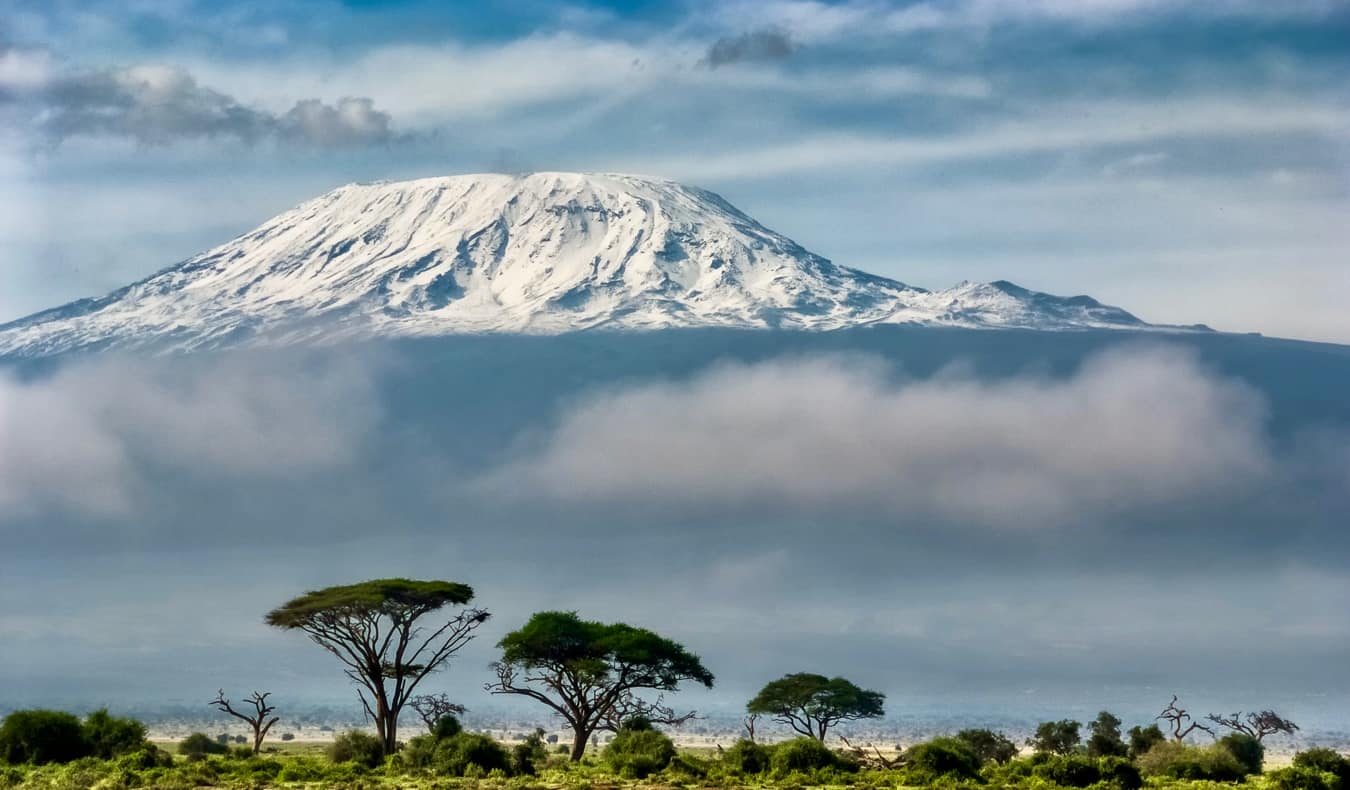



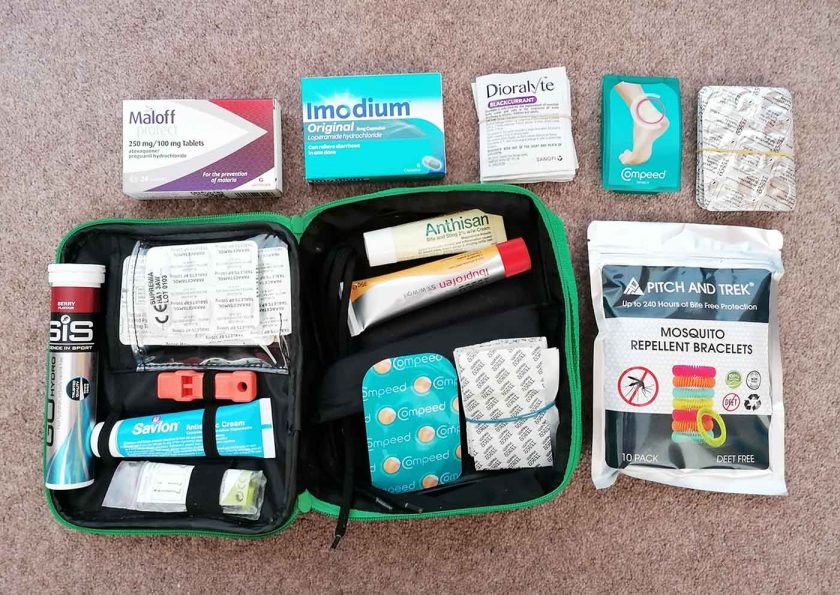

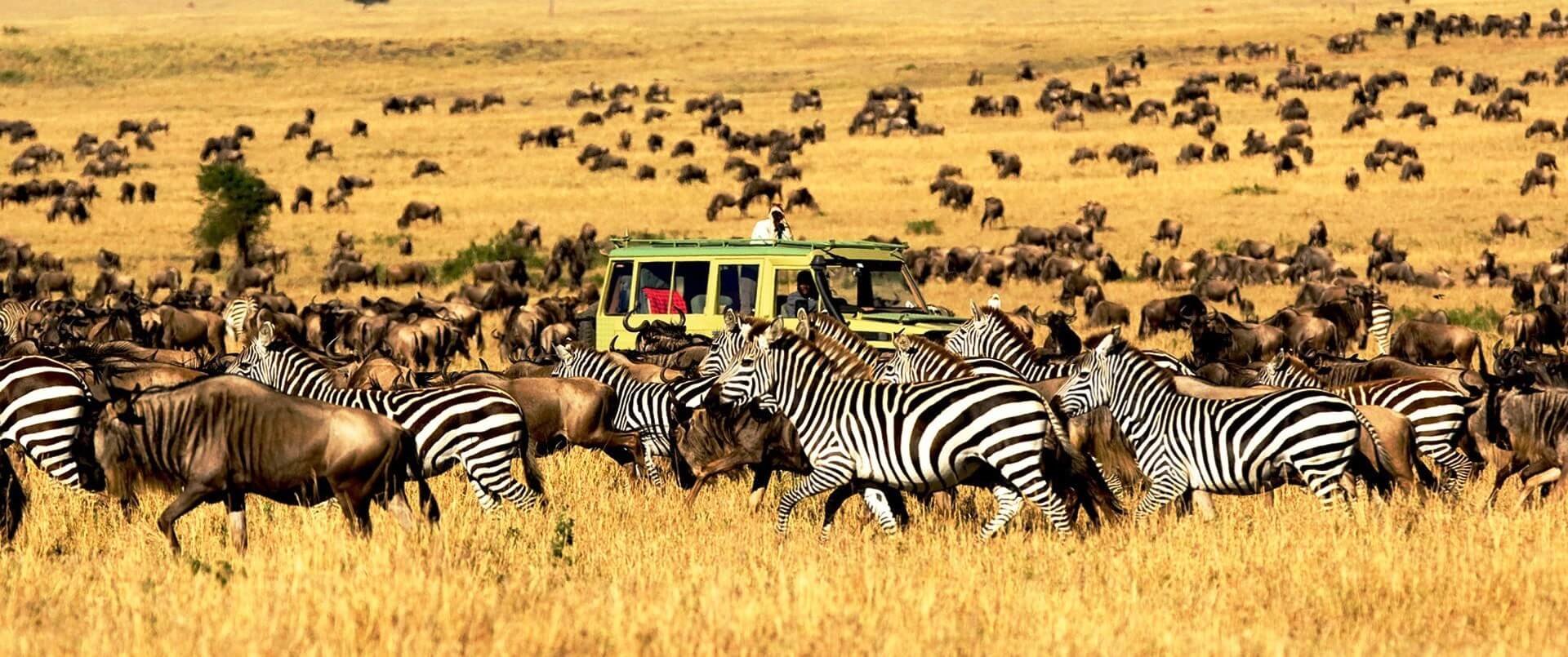

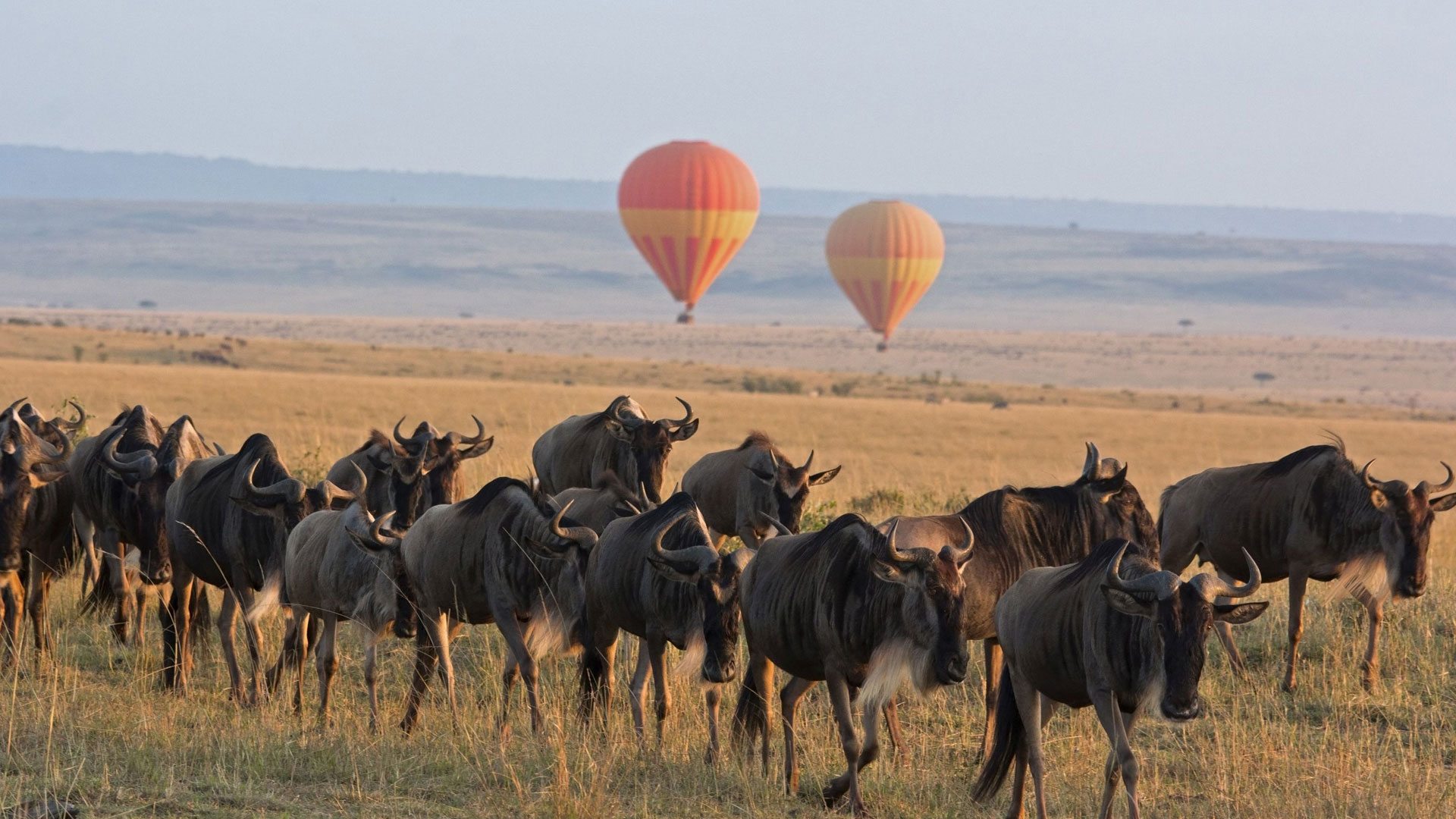
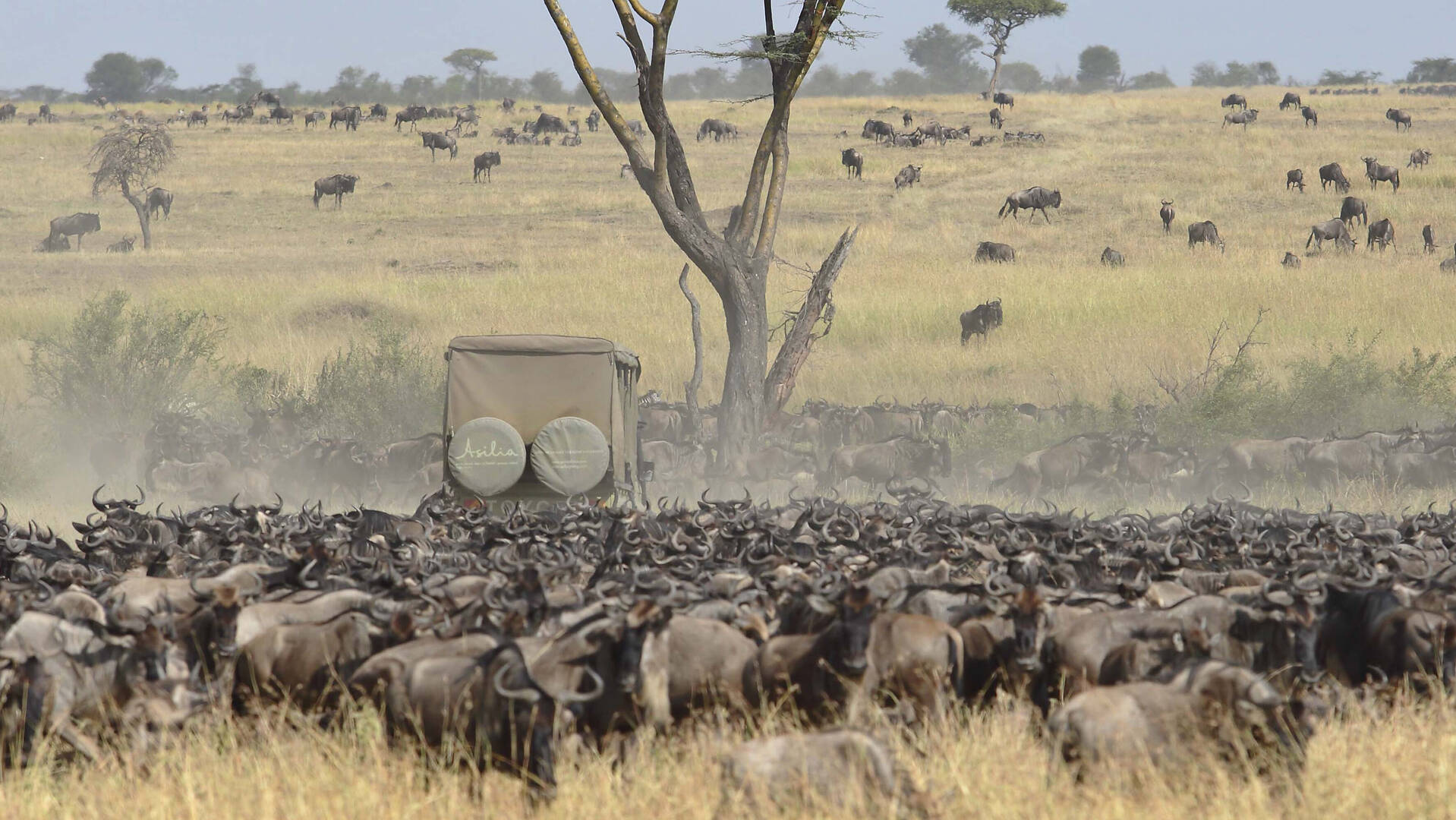
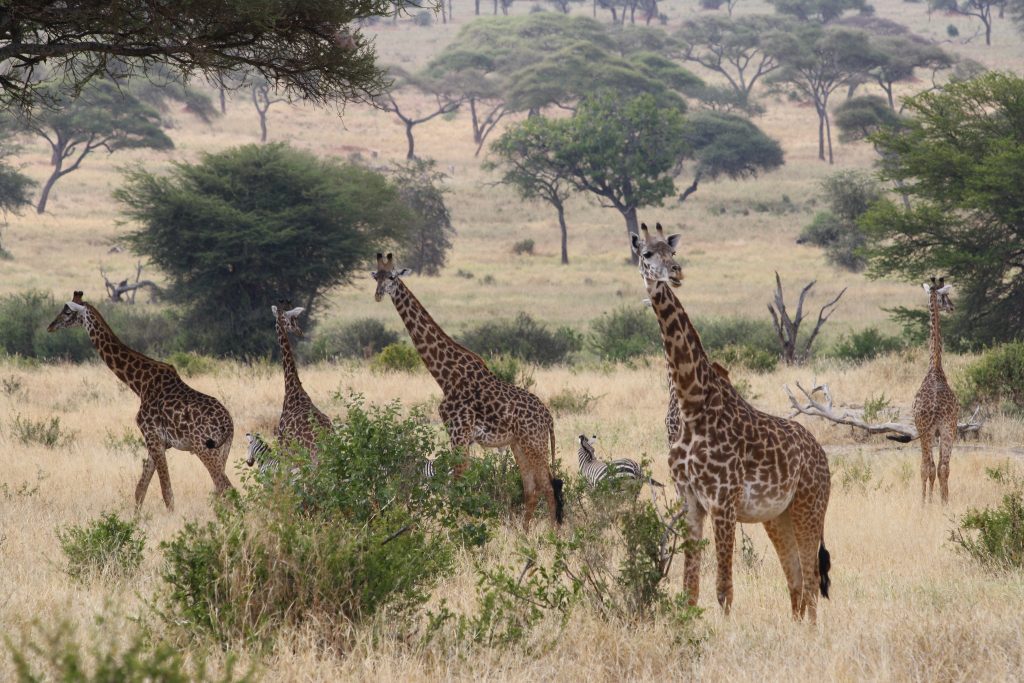
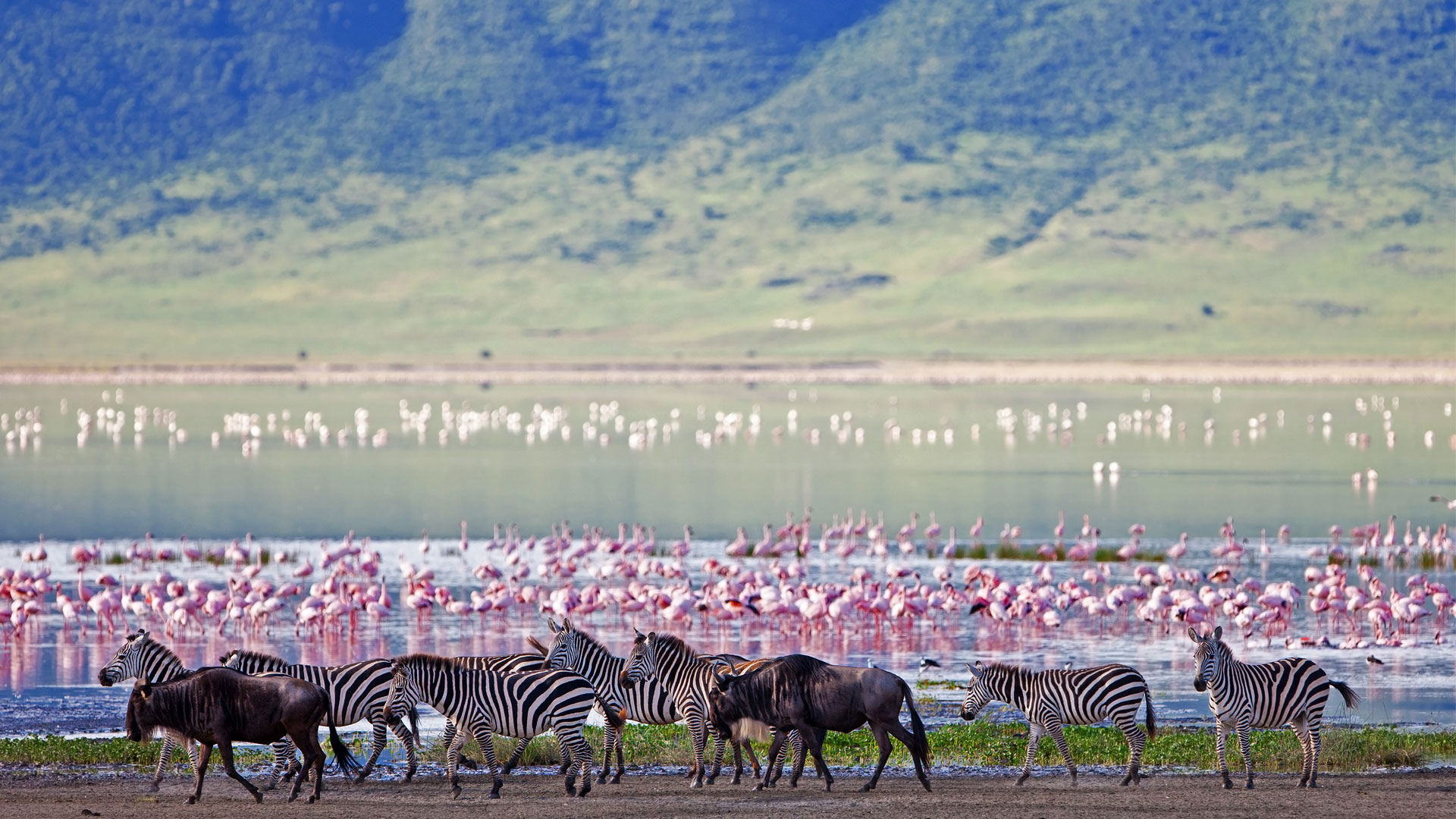
0 comments:
Post a Comment